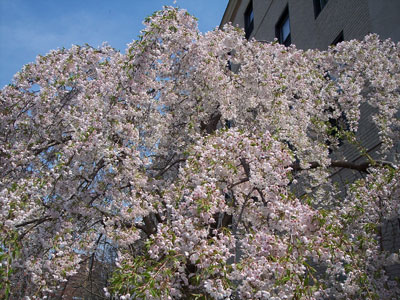Bruno Recalibration by Matt McGann '00
It was 86 degrees F in Boston on Wednesday!

A blooming tree in front of the Senior House dormitory
Now, I’m in New Jersey for the wedding of an MIT roommate. Lots of old friends from across the country are coming in for the festivities. Most of us know each other as we chose to live in Baker House for our 4 undergraduate years.
Baker House has been in the news lately because on Thursday, it revived an old MIT/Baker tradition: the piano drop. According to The Tech, “The piano drop was first enacted in 1972. It was conceived by a Baker resident, Charles Bruno ’74, who wanted to bring back the grand old hacks of the past. In honor of him a new unit of volume was created: the ‘Bruno.'”
Now the Bruno, like the Smoot, is a uniquely MIT unit of measure. Brush up on some of your MIT jargon…
Bruno - A unit of volume resulting from a piano falling six stories onto Amherst Alley from the roof of Baker House. [How To GAMIT 2004]
Bruno – A unit of volume equal to the size of the dent in asphalt resulting from the free fall of an upright piano. Determined to be 1158 cubic centimeters when the experiement was first performed in 1972. [MIT Club of Boston, 1999]
Thursday’s piano drop was the first since I was an MIT sophomore. It had been performed annually between 1972 and 1984, when Amherst Alley (“dorm row”) was moved farther from Baker, eliminating the “test site” for recalibrating the Bruno. Nevertheless, the piano drop has occurred a number of times in the past 20 years. But since it has been 7 years since the “experiment,” this one made the local news. It is currently New England Cable News’ “video of the day.” The Tech also had some nice photos.
Thursday was another kind of drop date, that is the final day MIT students can “drop” a class. MIT is fairly flexible about things, as classes can be added to your schedule in the first 5 weeks of the term, and can be dropped from your schedule up to 10 weeks into term. Also, Thursday was also the first day of Spring Weekend, featuring the Fierce Forever drag show, which Alison blogged about here.
And given that today, Friday, is Earth Day, I thought I’d take the opportunity to highlight just a few of MIT’s cool environmental programs:
- The freshman year Terrascope program: “Terrascope is an integrated studies program in which the Earth System is used as a context for the first-year core subjects in math, physics, chemistry and biology. It is a small learning community in which you will be encouraged to explore how these core disciplines, as well as engineering and humanities, are applied to understanding the structure and evolution of our planet.”
- The Earth System Initiative: “Planet Earth is a monument to the magnificent complexity that can arise from interactions among physical, chemical and biological processes. Understanding the nature of these interactions is one of the grand challenges for science and will require the coordinated efforts of scientists, engineers from what are traditionally distinct disciplines. The Earth System Initiative at MIT is a new multidisciplinary research and education effort that is committed to bringing together scientists and engineers from these different disciplines. Our goal is to forge new understandings of how different aspects of the Earth’s natural systems interact with and depend upon one another.”
- “The Environment at MIT” website: “MIT’s focus on the environment spans many facets of life in our community – from the strategic goals and policy of our administration, to the academic programs and research activities of our faculty and students, to recycling, composting, green goods procurement, and toxic use reduction initiatives across our entire community. Use this site to learn about everything environmental at MIT: our vision of environmental responsibility; how we deliver on that vision in our teaching, research, and operations; and how you can become involved.”
- Major in Science of Earth’s Environment (SeE): “Some of the greatest challenges confronting our society are related to how we influence the environment of our planet. The evolution of Earth through time is determined by the interactions of the solid earth, its fluid envelope of sea and sky, and the life forms that dwell upon it. Understanding this evolution – and thus providing a context for judging human impacts – requires a multidisciplinary, systems-oriented approach. Through its new SeE program, MIT provides students the opportunity to obtain an undergraduate degree in Earth, Atmospheric, and Planetary Sciences with a concentration in the environmental sciences. SeE emphasizes basic quantitative sciences (physics, chemistry, geology, and biology), the emerging science of complexity, and the role of science in shaping environmental policy. Graduates are prepared well for advanced post-graduate work in fields as varied as climatology environmental law, geochemistry, public policy, and environmental resource management. Graduates not electing to pursue more advanced degrees may find employment with environmental consulting firms, as naturalists, or as teachers.”
Finally, don’t forget that Friday is also the second day of Spring Weekend, with the International Fair in the afternoon and the Spring Concert, featuring Fabolous & Lloyd Banks.
As for me, I’m off to the rehearsal dinner…